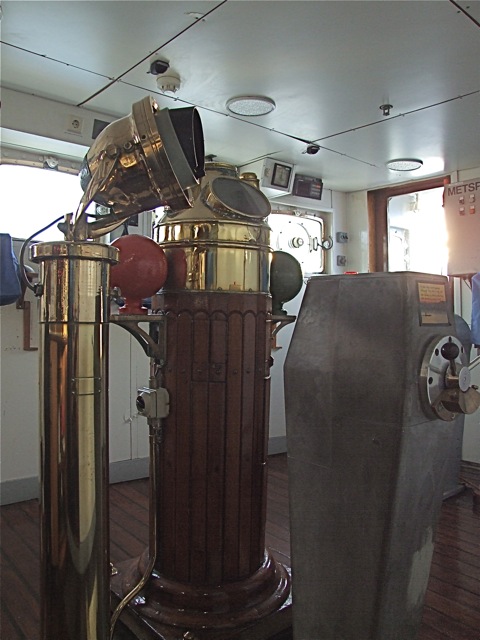- www.doulos1914.blogspot.my
We have journeyed so far, yet still so much to discover. If you missed my previous
posts, do click
Two Years After the Titanic to read them. And now, continuing past the waterline and up we go to the place where you'd hear commands passed and repeated back between officer and watchmen - where most newly joined deckhand wants to be. The Doulos bridge - the heart of navigating the still and stormy waters.
Traditionally called the
quarterdeck, where only officers or high-ranking personnel and appointed seamen stood during watches. On this deck, parties and occasional ceremonies were held only for the selected few. The place was a respected and well-regarded cove. Most people would be familiar with
Captain Barbossa and
Jack Sparrow from the well-known Hollywood movie, standing there and shouting out commands - that would be from the quarterdeck. As ship designs and steering systems evolved throughout the seafaring age, the
helmsman's position and quarterdeck, merged and raised higher in order to have an elevated position in which to commandeer a vessel.
- provided by www.ssmaritime.net
The helmsman who steered the ship would be in the
wheelhouse and the officer would be on the bridge. Helm orders were ‘passed down’ to the enclosed wheelhouse (where the helmsman operated the ‘wheel’) and repeated back for verification. This practice is still used till today. It serves as a ‘safety-indicator’ that orders were understood and duly executed. In the old days, some bridge were the ‘open-air’ type - they were exposed to the physical elements. But gradually, commands could be issued from a sheltered enclosure. These two positions would later merge as one which the term used interchangeably known as pilot house, or bridge.
The all-brass and wooden compass binnacle and the modern joystick 'wheel.'
www.doulos1914.blogspot.my
In larger powered-motor vessels, engine commands would be relayed to the engineer in the engine room by an
engine telegraph which displayed the captain's (or duty officer’s) orders on a dial. There would be two ‘dials’ - one on the bridge and the other, down in the engine room. The central command of a ship lies in the bridge itself. All ship navigation and controls are handled from the bridge where the duty officer and his bridge team make and issue commands to ensure a safe voyage possible.
www.doulos1914.blogspot.my
The Doulos bridge is no different from the others. Well,...only one fact. Unless there is another one outside a museum, and floating - it is old and (if not for certification sake) still functions. As mentioned in my post
Underway - 1914, the compass binnacle was acquired for another ship that time, but it was put on the SS Medina instead. The ship was christened in 1914 and logically speaking, the binnacle would had been made earlier. This would make it (other than the hull itself) one of few items that were originally fitted on the
Medina as she launched off the dock that year.
Underneath the coats of paint and modern innovations that went ‘on top’ of each other, the bridge is like a historical strata of information and composite - much like a prized archeological artefact. I can testify to this, as a deckhand chipping rust off the hull, applying primer and paint afterwards, the chunk of paint that came off was as thick as a piece of bread!
More to come! Hope you're standing on the top of the mainmast, when you see land...you'll know my next post is not too far to wait!







